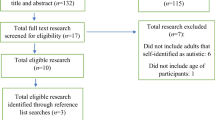Abstract
Children are increasingly seen as competent informants on their activities, views and needs. Different abilities of children can lead to inadequate (formally or regarding the content) answers or to the misunderstanding of proceedings during an interview process. One inadequate or at least unintended (on the part of the researcher) response is a “don’t know” answer (DK). To study when and why DK answers occur, a possible cause for them in the cognitive process and their relation to age, we analysed the DK answers given in qualitative semi-structured interviews with children aged 5–11, conducted face-to-face and on the telephone. Each of 56 children was interviewed twice, once face-to-face and once via telephone. The results show that age had an effect on DK responses due to the cognitive state of the respondent and their communicative intent, but there was no difference in the number of DKs due to problems with the research instrument or due to an adequacy judgement in respect of respondent age.
Similar content being viewed by others
References
Beatty P., Herrmann D., Puskar C., Kerwin J.: “Don’t know” responses in surveys: is what i know what you want to know and do i want you to know it?. Memory 6, 407–426 (1998)
Bell A.: Designing and testing questionnaires for children. J. Res. Nurs. 12(5), 461–469 (2007)
Borgers N., Hox J.: Item nonresponse in questionnaire research with children. J. Off. Stat. 17(2), 321–335 (2001)
Borgers N., Hox J., Sikkel D.: Response quality in survey research with children and adolescents: the effect of labeled response options and vague quantifiers. Int. J. Public Opin. Res. 15(1), 83–94 (2003)
Borgers N., Hox J., Sikkel D.: Response effects in surveys on children and adolescents. Qual. Quant. 38, 17–34 (2004)
Cordón I.M., Saetermoe C.L., Goodman G.S.: Facilitating children’s accurate responses: conversational rules and interview style. Appl. Cogn. Psychol. 19, 249–266 (2005)
de Leeuw E., Borgers N., Smits A.: Pretesting questionnaires for children and adolescents. In: Presser, S., Rothgeb, J., Couper, M., Lessler, J., Martin, E., Martin, J., Singer, E. (eds) Methods for Testing and Evaluating Survey Questionnaires, pp. 409–429. Wiley, Hoboken (2004)
Donaldson M.: Wie Kinder denken. Huber, Bern (1982)
Fuhs, B.: Qualitative interviewsmit kinder. In: Heinzel, F. (ed.)Methoden der Kindheitsforschung. Ein Überblick über Forschungszugänge zur kindlichen Perspektive, pp. 87–104. Juventa, Weinheim (2000)
Fuchs, M.: Children and Juveniles as Respondents: Experiments on Question Order, Response Order, and Scale Effects. In: Presented at the International Conference on Improving Surveys. Copenhagen. www.icis.dk/ICIS_papers/F_2_4.pdf (2002). Accessed 4 Sept 2007
Garbarino J., Stott F.M.: Faculty of the Erikson Institute: What Children Can Tell Us: Eliciting, Interpreting, and Evaluating Information Form Children. Jossey-Bass, San Francisco (1989)
Groves R.M., Fowler F., Couper M., Lepkowski J., Singer E., Tourangeau R.: Survey Methodology. Wiley, Hoboken (2004)
Holaday B., Turner-Henson A.: Response effects in surveys with school-age children. Nurs. Res. 38(4), 248–250 (1989)
Hughes M., Grieve R.: On asking children bizarre questions. First Lang. 1, 149–160 (1980)
Knäuper, B.: Age differences in question and response order effects. In: Schwarz, N., Park, D., Knäuper, B. , Sudman, S. (eds.) Cognition, Ageing, Self-Report, pp. 341–364. Taylor and Francis, Philadelphia (1999)
Krappmann, L.: Sozialisation in der Gruppe der Gleichaltrigen. In: Hurrelmann, K., Ulich, D. (eds.) Neues Handbuch der Sozialisationsforschung, pp. 355–375. Weinheim, Beltz (1991)
Krosnick J.A.: Response strategies for coping with the cognitive demands of attitude measures in surveys. Appl. Cogn. Psychol. 5, 213–236 (1991)
Mead G.H.: Geist, Identität und Gesellschaft. Suhrkamp, Frankfurt (1975)
Piaget J.: Introduction to the Child’s Conception of the World. Harcourt, New York (1929)
Scott, J.: Children as respondents: methods for improving data quality. In: Lyberg, L., Biemer, P., Collins, M., De Leeuw, E., Dippo, C., Schwarz, N., Trewin, D. (eds.) Survey Measurement and Process Quality, pp. 331–351. Wiley, New York (1997)
Scott, J., Brynin, M., Smith, R.: Interviewing children in the British houshold panel survey. In: Hox, J., van der Meulen, B., Janssens, J., ter Laak, J., Tavecchio, L. (eds.) Advances in Family Research, pp. 259–266. Thesis Publishers, Amsterdam (1995)
Shoemaker P., Eichholz M., Skewes E.: Item-nonresponse. Distinguishing between don’t know and refuse. Int. J. Public Opin. Res. 14, 193–201 (2002)
Tourangeau R., Rips L., Rasinski K.: The Psychology of Survey Response. Cambridge University Press, Cambridge (2000)
Waterman A.H., Blades M., Spencer C.: Do children try to answer nonsensical questions?. Br. J. Dev. Psychol. 18, 211–225 (2000)
Waterman A.H., Blades M., Spencer C.: Interviewing children and adults: the effect of question format on the tendency to speculate. Appl. Cogn. Psychol. 15, 521–531 (2001)
Author information
Authors and Affiliations
Corresponding author
Rights and permissions
About this article
Cite this article
Vogl, S. Children between the age of 5 and 11: what “don’t know” answers tell us. Qual Quant 46, 993–1011 (2012). https://doi.org/10.1007/s11135-011-9438-9
Published:
Issue Date:
DOI: https://doi.org/10.1007/s11135-011-9438-9




